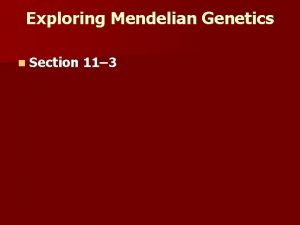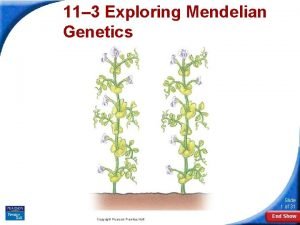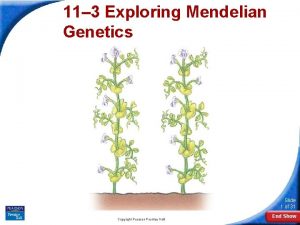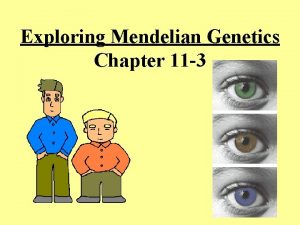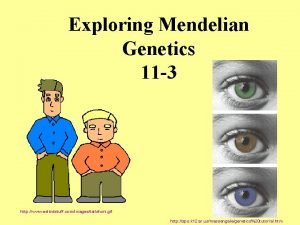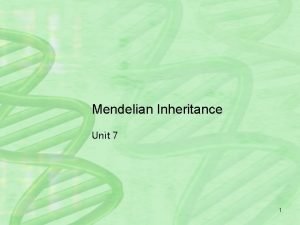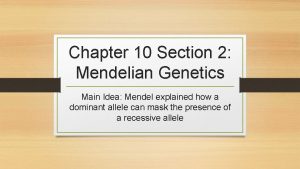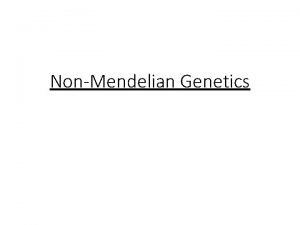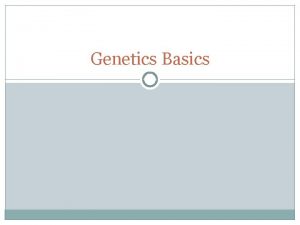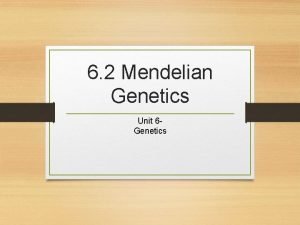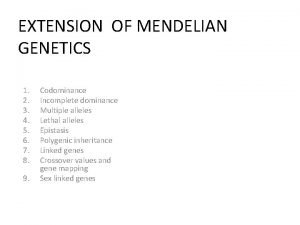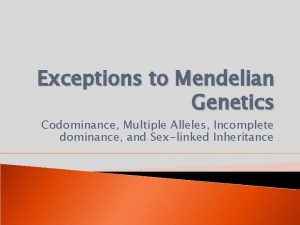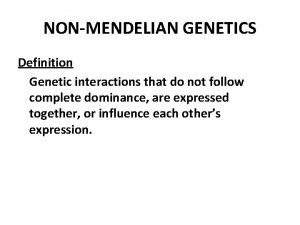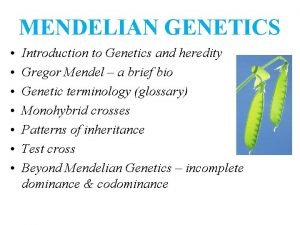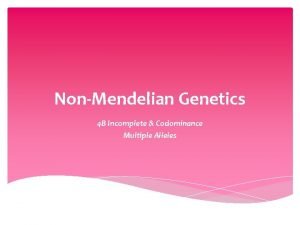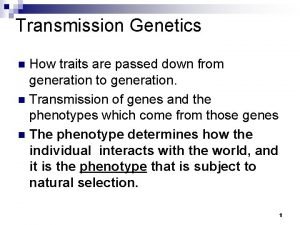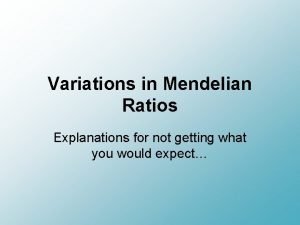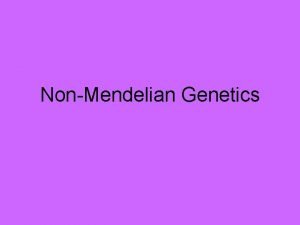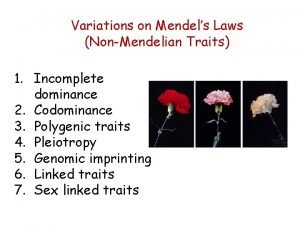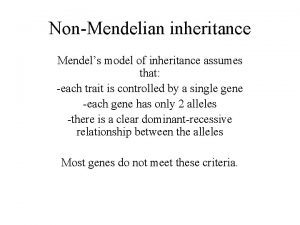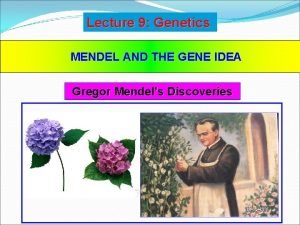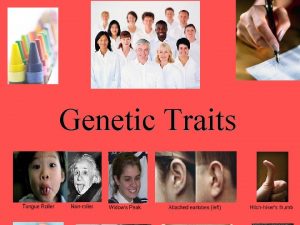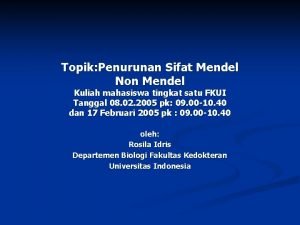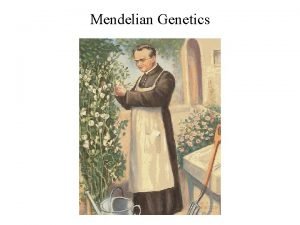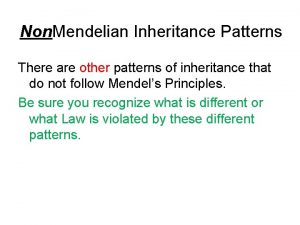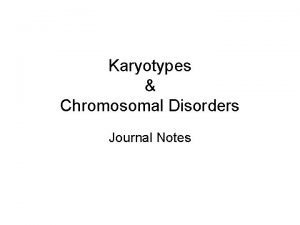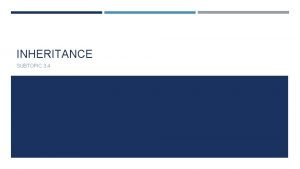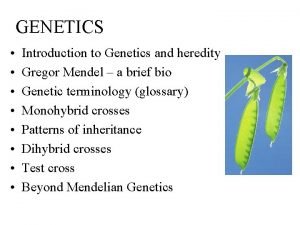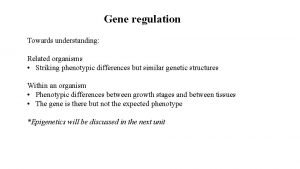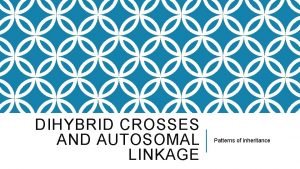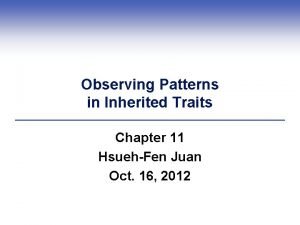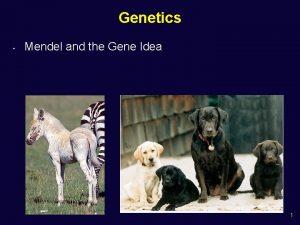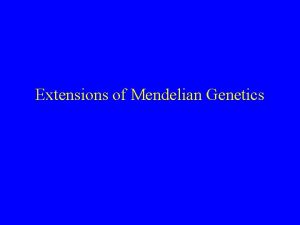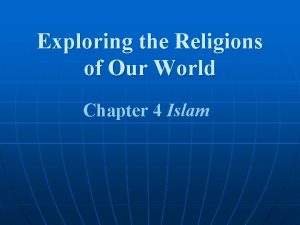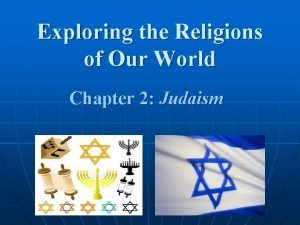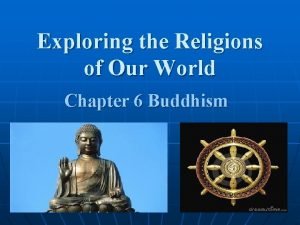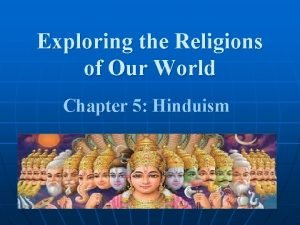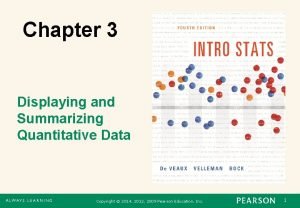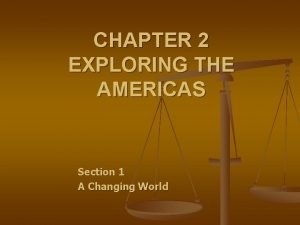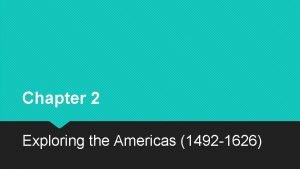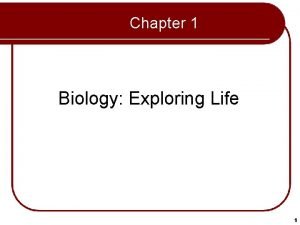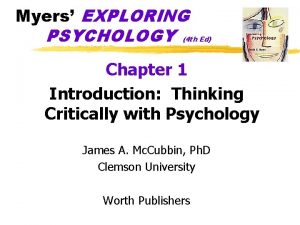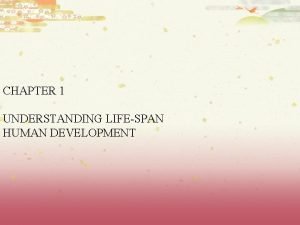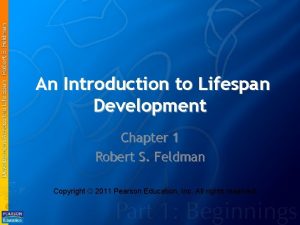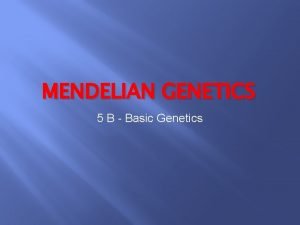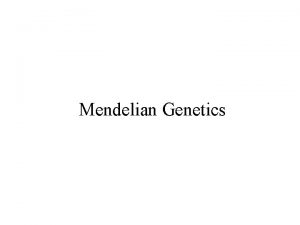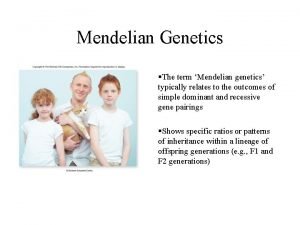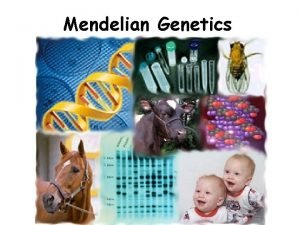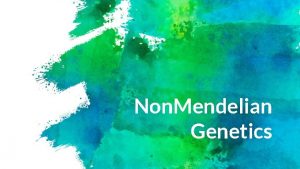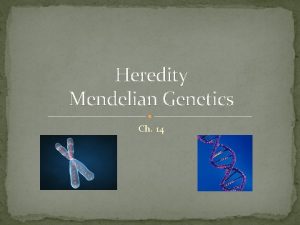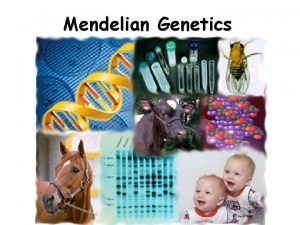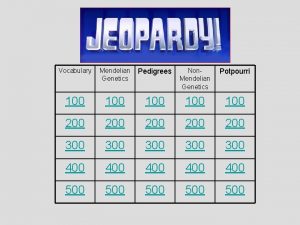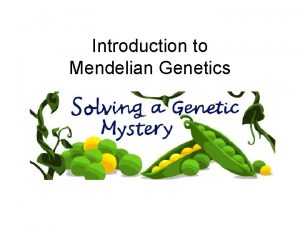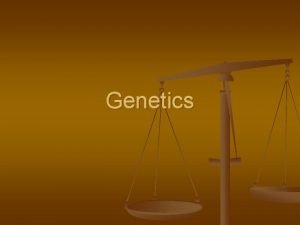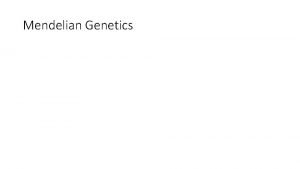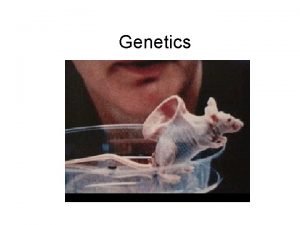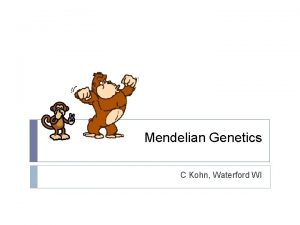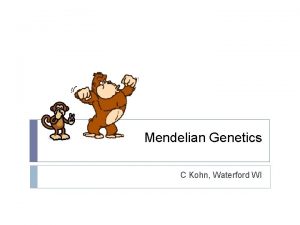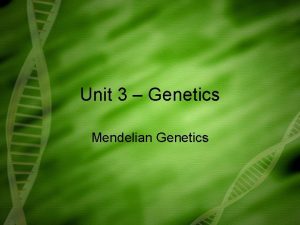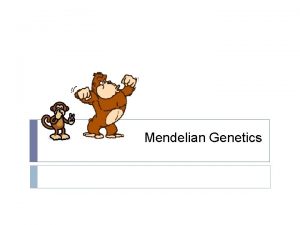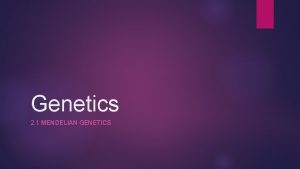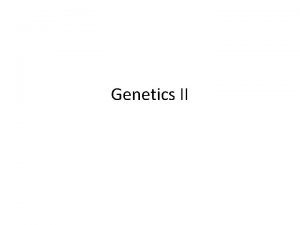Exploring Mendelian Genetics Chapter 11 3 Transmission of































































- Slides: 63

Exploring Mendelian Genetics Chapter 11 -3

Transmission of characteristics from parents to offspring is called: A. Heredity B. Genetics C. Genes D. Homozygous

The science that studies HOW those characteristics are passed down from one generation to the next is called: A. Heredity B. Genetics C. Genes D. Homozygous

Mendel theorized that there must be ___ “factors” that control each trait. A. 1 B. 2 C. 3 D. 4

Different gene choices for a trait are called: A. Genes B. Homozygous C. Heterozygous D. Alleles

What is the term given when a trait is controlled by two contrasting alleles?

What is the term given when a trait is controlled by two identical alleles?

When a DOMINANT allele is paired with a recessive allele, the DOMINANT trait will mask the recessive trait. This is known as the Principal of ________? A. Traits B. Segregation C. Dominance

GENES are more complicated than Mendel thought ENVIRONMENT influences the ______________. expression of genes “Nature vs Nurture” = ____________ provide the plan Genes ______ for development, but how plan unfolds also depends on _______conditions. environmental _______

GENES are more complicated than Mendel thought Some traits have choices ______ MORE than 2 allele _____ MULTIPLE ALLELE TRAIT = __________ EX: blood type B ___ O A ___ Allele choices ___

GENES are more complicated than MENDEL thought Some traits are determined by MORE THAN ONE GENE ______________ POLYGENIC TRAIT = _________ EX: human height. intelligence, skin & eye color

GENES are more complicated than MENDEL thought Traits determined by ______ MORE than ONE gene have _________ many “______” in-between phenotypes There aren’t just SMART people and DUMB people…. there is a ________ whole range of intelligences in-between

GENES are more complicated than MENDEL thought KINDS OF DOMINANCE __________ COMPLETE DOMINANCE INCOMPLETE DOMINANCE __________ CO-DOMINANCE __________

COMPLETE DOMINANCE Dominant allele _______ masks _____ the ______ recessive one PATTERN ? Recessive allele ______ returns in a _____ratio in the 3: 1 ____ F 2 generation

INCOMPLETE DOMINANCE DON’T SEE expected _____ 3: 1 ratio in F 2 generation Heterozygous organisms with one _______ dominant and one recessive allele show a _____ BLENDED in-between trait

CO-DOMINANCE BOTH traits are expressed at _______ SAME TIME (___________) in heterozygote NO BLENDING ROAN A ____HORSE has _______ BOTH RED hair and _____ WHITE hair side by side

CO-DOMINANCE Both traits are expressed together (NO BLENDING) in heterozygote Persons with an A allele AND a B allele have blood type AB

REMEMBER Membrane proteins with _______ sugars attached that help cells recognize self = _______ GLYCOPROTEINS

BLOOD TYPES have more than 2 allele choices MULTIPLE ALLELE TRAIT = _____________ The pattern of sugars that is attached is determined by genes Allele choices are: A B O _____

BLOOD TYPES An A allele tells the cell to put “A” glycoproteins on its surface

BLOOD TYPES A B allele tells the cell to put a different “B” glycoprotein on its surface

BLOOD TYPES An O allele tells the cell NOT to put anything on the surface

A and B are CO-DOMINANT A cell with BOTH an A and a B allele has BOTH “A” and “B” glycoproteins on its surface

BLOOD TYPES & ALLELES GENOTYPE AA AO BB BO OO AB PHENOTYPE (BLOOD TYPE) A A B B O AB

DONOR BLOOD A and AB see A as “like me” B and O see A as Different! IMMUNE SYSTEM ATTACKS!

DONOR BLOOD B and AB see B as “like me” A and O see B as Different! IMMUNE SYSTEM ATTACKS!

DONOR BLOOD O can donate to ____ EVERY BLOOD TYPE = ___________ UNIVERSAL DONOR Nothing on surface to recognize as “NOT SELF” YOU DON’T HAVE ANYTHING I DON’T HAVE!

DONOR BLOOD Only AB sees AB as “like me” A, B, and O see AB as Different! IMMUNE SYSTEM ATTACKS!

AB can only GIVE to AB BUT. . . AB can RECEIVE FROM ______ EVERY BLOOD TYPE = ____________ UNIVERSAL RECIPIENT

BLOOD TYPE FREQUENCY IN USA A B AB O 42% 10% 4% 44%

ABO SYSTEM is NOT THE ONLY ONE + Rh Rh

OTHER BLOOD TYPES __________ IF: NO PROBLEMS Rh+ MOM is _____ & BABY is _____ Rh+ MOM is _____ Rh+ & BABY is ____ Rh-

PROBLEM IF: Can be a ______ Mom is _____ Rh- Baby is _____ Rh+ 1 st baby OK but few baby cells entering mom’s bloodstream put mom’s immune system on alert for + cells. Next + baby, mom’s immune system can attack baby as it is growing Mom given shot after 1 st birth prevents this

DIHYBRID CROSSES (2 traits)

Mendel also asked the question? Does the gene that determines if a seed is round or wrinkled have anything to do with the gene for seed shape? Must a seed that is yellow also be round?

MAKING A CROSS with TWO gene traits __________= DIHYBRID CROSS __________ A Punnett square for a DIHYBRID CROSS looks like this:

Figure 11 -10 Independent Assortment in Peas Section 11 -3 Go to Section:

LET’S MAKE A DIHYBRID CROSS HOMOZYGOUS YELLOW ROUND RRYY HOMOZYGOUS GREEN WRINKLED rryy 1. Figure ______ are out what _________ parent alleles 2. Choose ____correct_____ Punnett square _____ size 3. Put ______ in possible____________ parent gametes 4. Fill ______ in boxes with ___________ offspring combinations 5. Determine ______of_______& probabilities phenotypes ______ genotypes

LAW OF INDEPENDENT ASSORTMENT _____________ the factors are distributed to gametes independently of other factors

PRACTICE MAKING GAMETES WHAT ARE THE POSSIBLE GAMETES THIS PARENT CAN MAKE? HOMOZYGOUS ROUND YELLOW RRYY Each gamete should get one of each kind of gene R Y RY ____________ RY _______

PRACTICE MAKING GAMETES WHAT ARE THE POSSIBLE GAMETES THIS PARENT CAN MAKE? HOMOZYGOUS WRINKLED GREEN rryy Each gamete should get one of each kind of gene r y ry ____________ ry _______

PRACTICE MAKING GAMETES WHAT ARE THE POSSIBLE GAMETES THIS PARENT CAN MAKE? HETEROZYGOUS ROUND YELLOW Rr. Yy Each gamete should get one of each kind of gene R Y r y r. Y ____________ Ry _______

ry ry RY Rr. Yy Rr. Yy genotype 100% of offspring = _______ ROUND YELLOW phenotype ____________

MAKE ANOTHER CROSS HETEROZYGOUS ROUND YELLOW Rr. Yy X HETEROZYGOUS ROUND YELLOW Rr. Yy

POSSIBLE PARENT GAMETES? RY ry r. Y Ry

RY Ry r. Y ry RRYY RRYy Rr. YY Rr. Yy ____ 9 Round & Yellow Ry RRYy RRyy Rr. Yy Rryy 3 Round & ____ green r. Y Rr. Yy rr. YY rr. Yy 3 Wrinkled ____ & yellow rryy 1 wrinkled ____ & green RY ry Rr. Yy Rryy rr. Yy heterozygous dihybrid cross is a Sign of a ___________ 9: 3: 3: 1 ratio in offspring.

____ 9 ______ dominant TRAIT 1 ; ______ dominant TRAIT 2 3 ______ dominant TRAIT 1; _______ recessive ____ TRAIT 2 recessive TRAIT 1; _______ dominant 3 ______ TRAIT 2 1 ______ recessive TRAIT 1; _______ recessive 9: 3: 3: 1 _____ratio is a clue that it’s a ______________cross HETEROZYGOUS TWO gene

PRACTICE MAKING GAMETES for DIHYBRID CROSSES

What are the possible gametes? RRTT pure round & pure tall = _____ R T ______ RT What gametes can it produce?

Tt. RR Heterozygous Tall = _____ & pure round What are the possible gametes? ____ T R ____ t R ______ TR What gametes can it produce?

What are the possible gametes? Ttrr = _____ Hybrid tall & pure wrinkled ____ T r ____ t r ______ Tr What gametes can it produce?

What are the possible gametes? t. Rr =T _____ Heterozygous tall & hybrid round ____ T R ____ t r _____ t R ______ Tr What gametes can it produce?

HUMAN GENETICS 1. Human Genetics • Genes on chromosomes #1 -22 = AUTOSOMAL • Genes on sex chromosomes = SEX-LINKED

2. Human Genome Project • Completed in 2003 • International scientific project • Identified over 90% of our genes • HUGE science advancement

3. Sex Linked Genes • Sex-linked genes on Xchromosome are “X-linked genes” • Sex-linked genes on Ychromosome are “Y-linked genes” • X chr. much LARGER than Y chr. , so it carries more genes.

4. Sex-linked Disorders 1. Colorblindness = cannot distinguish certain colors (redgreen most common) • recessive X-linked • males more likely to be colorblind

WHY? • males only need 1 recessive X to be colorblind • females must have 2 recessive X to be colorblind

2. Hemophilia = disorder where blood does not clot • recessive X-linked • men more likely to have hemophilia

5. Detecting Human Genetic Disorders 1. Pedigree = diagram showing how a trait is inherited over several generations

Normal Male with condition Male CARRIER for condition

Normal Female with condition Female CARRIER for condition

Carrier = Person has 1 copy of a recessive allele • Does not show trait

 Section 11-3 exploring mendelian genetics answer key
Section 11-3 exploring mendelian genetics answer key Section 11-3 exploring mendelian genetics
Section 11-3 exploring mendelian genetics 11-3 exploring mendelian genetics answers
11-3 exploring mendelian genetics answers 11-3 exploring mendelian genetics answers
11-3 exploring mendelian genetics answers Section 11-3 exploring mendelian genetics answer key
Section 11-3 exploring mendelian genetics answer key 11-3 exploring mendelian genetics
11-3 exploring mendelian genetics Family resemblance test
Family resemblance test Chapter 7 extending mendelian genetics answer key
Chapter 7 extending mendelian genetics answer key Chapter 10 section 2 mendelian genetics answer key
Chapter 10 section 2 mendelian genetics answer key Chapter 7 vocabulary practice extending mendelian genetics
Chapter 7 vocabulary practice extending mendelian genetics Blood type dominant recessive
Blood type dominant recessive Chapter 7 extending mendelian genetics vocabulary practice
Chapter 7 extending mendelian genetics vocabulary practice Dominant
Dominant What is heterozygous type b blood
What is heterozygous type b blood Mendelian genetics punnett square
Mendelian genetics punnett square Karyotype
Karyotype Pprr x pprr punnett square
Pprr x pprr punnett square Exceptions to mendelian genetics
Exceptions to mendelian genetics Mendelian genetics definition
Mendelian genetics definition Codominance example
Codominance example Mendels three laws of inheritance
Mendels three laws of inheritance Chapter 10 sexual reproduction and genetics
Chapter 10 sexual reproduction and genetics What are mendelian traits
What are mendelian traits The scientific study of heredity *
The scientific study of heredity * What does incomplete dominance mean
What does incomplete dominance mean Mendelian genetics concept map
Mendelian genetics concept map Transmission genetics
Transmission genetics Blood type matrix
Blood type matrix Non mendelian inheritance
Non mendelian inheritance Drug
Drug Non mendelian law
Non mendelian law Non mendelian law
Non mendelian law Cystic fibrosis mendelian inheritance
Cystic fibrosis mendelian inheritance Mendelian traits
Mendelian traits Postulat mendel
Postulat mendel Probability laws govern mendelian inheritance
Probability laws govern mendelian inheritance Mendelian inheritance patterns
Mendelian inheritance patterns Difference between mendelian and chromosomal disorders
Difference between mendelian and chromosomal disorders Mendel law
Mendel law Inheritance vs heredity
Inheritance vs heredity Duplicate dominant epistasis
Duplicate dominant epistasis Autosomal dihybrid cross
Autosomal dihybrid cross Mendelian traits
Mendelian traits Mendel's experimental design
Mendel's experimental design Mendelian
Mendelian H antigen
H antigen Chapter 26 exploring the universe answers
Chapter 26 exploring the universe answers Exploring religions chapter 4 large
Exploring religions chapter 4 large Physical development
Physical development Exploring globalization textbook pdf chapter 11
Exploring globalization textbook pdf chapter 11 Exploring the religions of our world chapter 2 pdf
Exploring the religions of our world chapter 2 pdf Exploring the religions of our world chapter 1 pdf
Exploring the religions of our world chapter 1 pdf Exploring religions chapter 6 large
Exploring religions chapter 6 large Exploring religions chapter 5 large
Exploring religions chapter 5 large Summarizing quantitative data
Summarizing quantitative data Chapter 2 exploring the americas study guide
Chapter 2 exploring the americas study guide Chapter 2 exploring the americas answer key
Chapter 2 exploring the americas answer key Images
Images Exploring psychology chapter 1
Exploring psychology chapter 1 Exploring lifespan development chapter 1
Exploring lifespan development chapter 1 Exploring lifespan development chapter 1
Exploring lifespan development chapter 1 Chapter 22 genetics and genetically linked diseases
Chapter 22 genetics and genetically linked diseases Chapter 12 section 1 dna the genetic material
Chapter 12 section 1 dna the genetic material Chapter 12 section 1 dna the genetic material
Chapter 12 section 1 dna the genetic material

